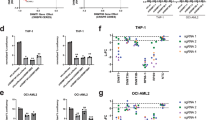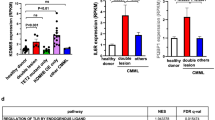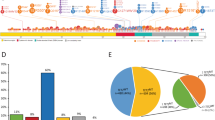Abstract
TET2 is a close relative of TET1, an enzyme that converts 5-methylcytosine (5mC) to 5-hydroxymethylcytosine (5hmC) in DNA1,2. The gene encoding TET2 resides at chromosome 4q24, in a region showing recurrent microdeletions and copy-neutral loss of heterozygosity (CN-LOH) in patients with diverse myeloid malignancies3. Somatic TET2 mutations are frequently observed in myelodysplastic syndromes (MDS), myeloproliferative neoplasms (MPN), MDS/MPN overlap syndromes including chronic myelomonocytic leukaemia (CMML), acute myeloid leukaemias (AML) and secondary AML (sAML)4,5,6,7,8,9,10,11,12. We show here that TET2 mutations associated with myeloid malignancies compromise catalytic activity. Bone marrow samples from patients with TET2 mutations displayed uniformly low levels of 5hmC in genomic DNA compared to bone marrow samples from healthy controls. Moreover, small hairpin RNA (shRNA)-mediated depletion of Tet2 in mouse haematopoietic precursors skewed their differentiation towards monocyte/macrophage lineages in culture. There was no significant difference in DNA methylation between bone marrow samples from patients with high 5hmC versus healthy controls, but samples from patients with low 5hmC showed hypomethylation relative to controls at the majority of differentially methylated CpG sites. Our results demonstrate that Tet2 is important for normal myelopoiesis, and suggest that disruption of TET2 enzymatic activity favours myeloid tumorigenesis. Measurement of 5hmC levels in myeloid malignancies may prove valuable as a diagnostic and prognostic tool, to tailor therapies and assess responses to anticancer drugs.
This is a preview of subscription content, access via your institution
Access options
Subscribe to this journal
Receive 51 print issues and online access
$199.00 per year
only $3.90 per issue
Buy this article
- Purchase on Springer Link
- Instant access to full article PDF
Prices may be subject to local taxes which are calculated during checkout




Similar content being viewed by others
Accession codes
Primary accessions
Gene Expression Omnibus
Data deposits
Data have been deposited at GEO under accession number GSE25706 (methylation status of each CpG site (beta value) can be found in Supplementary Table 3).
Change history
09 December 2010
A panel was replaced in Fig. 1c and data accession information was added.
References
Tahiliani, M. et al. Conversion of 5-methylcytosine to 5-hydroxymethylcytosine in mammalian DNA by MLL partner TET1. Science 324, 930–935 (2009)
Iyer, L. M., Tahiliani, M., Rao, A. & Aravind, L. Prediction of novel families of enzymes involved in oxidative and other complex modifications of bases in nucleic acids. Cell Cycle 8, 1698–1710 (2009)
Viguié, F. et al. Common 4q24 deletion in four cases of hematopoietic malignancy: early stem cell involvement? Leukemia 19, 1411–1415 (2005)
Abdel-Wahab, O. et al. Genetic characterization of TET1, TET2, and TET3 alterations in myeloid malignancies. Blood 114, 144–147 (2009)
Delhommeau, F. et al. Mutation in TET2 in myeloid cancers. N. Engl. J. Med. 360, 2289–2301 (2009)
Jankowska, A. M. et al. Loss of heterozygosity 4q24 and TET2 mutations associated with myelodysplastic/myeloproliferative neoplasms. Blood 113, 6403–6410 (2009)
Langemeijer, S. M. et al. Acquired mutations in TET2 are common in myelodysplastic syndromes. Nature Genet. 41, 838–842 (2009)
Levine, R. L. & Carroll, M. A common genetic mechanism in malignant bone marrow diseases. N. Engl. J. Med. 360, 2355–2357 (2009)
Mullighan, C. G. TET2 mutations in myelodysplasia and myeloid malignancies. Nature Genet. 41, 766–767 (2009)
Tefferi, A. et al. Frequent TET2 mutations in systemic mastocytosis: clinical, KITD816V and FIP1L1-PDGFRA correlates. Leukemia 23, 900–904 (2009)
Tefferi, A. et al. Detection of mutant TET2 in myeloid malignancies other than myeloproliferative neoplasms: CMML, MDS, MDS/MPN and AML. Leukemia 23, 1343–1345 (2009)
Tefferi, A. et al. TET2 mutations and their clinical correlates in polycythemia vera, essential thrombocythemia and myelofibrosis. Leukemia 23, 905–911 (2009)
Ito, S. et al. Role of Tet proteins in 5mC to 5hmC conversion, ES-cell self-renewal and inner cell mass specification. Nature 466, 1129–1133 (2010)
Hayatsu, H. & Shiragami, M. Reaction of bisulfite with the 5-hydroxymethyl group in pyrimidines and in phage DNAs. Biochemistry 18, 632–637 (1979)
Huang, Y. et al. The behaviour of 5-hydroxymethylcytosine in bisulfite sequencing. PLoS ONE 5, e8888 (2010)
Lister, R. et al. Human DNA methylomes at base resolution show widespread epigenomic differences. Nature 462, 315–322 (2009)
Tefferi, A. Epigenetic alterations and anti-epigenetic therapy in myelofibrosis. Leuk. Lymphoma 49, 2231–2232 (2008)
Smith, L. T., Otterson, G. A. & Plass, C. Unraveling the epigenetic code of cancer for therapy. Trends Genet. 23, 449–456 (2007)
Esteller, M. Epigenetics in cancer. N. Engl. J. Med. 358, 1148–1159 (2008)
Gal-Yam, E. N., Saito, Y., Egger, G. & Jones, P. A. Cancer epigenetics: modifications, screening, and therapy. Annu. Rev. Med. 59, 267–280 (2008)
Ehrlich, M. DNA hypomethylation in cancer cells. Epigenomics 1, 239–259 (2009)
Lengauer, C. Cancer. An unstable liaison. Science 300, 442–443 (2003)
Bröske, A.-M. et al. DNA methylation protects hematopoietic stem cell multipotency from myeloerythroid restriction. Nature Genet. 41, 1207–1215 (2009)
Gaudet, F. et al. Induction of tumors in mice by genomic hypomethylation. Science 300, 489–492 (2003)
Walsh, C. P., Chaillet, J. R. & Bestor, T. H. Transcription of IAP endogenous retroviruses is constrained by cytosine methylation. Nature Genet. 20, 116–117 (1998)
Jiang, Y. et al. Aberrant DNA methylation is a dominant mechanism in MDS progression to AML. Blood 113, 1315–1325 (2009)
Acknowledgements
This work was supported by NIH grants R01 AI44432 and RC1 DA028422 (to A.R.), NIH grants K24 HL077522 and R01 HL098522, an Established Investigator award from the Aplastic Anemia & MDS Foundation, and an award from the Bob Duggan Memorial Research Fund (to J.P.M), NIH grant R01 HG4069 (to X.S.L.) and a pilot grant from Harvard Catalyst, The Harvard Clinical and Translational Science Center (NIH Grant #1 UL1 RR 025758-02, to S.A.). Y.H. was supported by postdoctoral fellowships from the GlaxoSmithKline-Immune Disease Institute (GSK-IDI) Alliance and the Leukemia and Lymphoma Society of America. H.S.B. is supported by a postdoctoral fellowship from the GSK-IDI Alliance.
Author information
Authors and Affiliations
Contributions
M.K. analysed the biochemical effects of patient-associated TET2 mutations and performed the in vitro differentiation studies; Y.H. generated and characterized the anti-CMS antiserum, developed the quantitative dot-blot assay and quantified 5hmC in DNA samples from patients and healthy controls. A.M.J., R.G. and J.P.M. provided patient and control DNA for 5hmC quantification, performed DNA methylation arrays and analysed TET2 mutational status in patients. U.J.P. and X.S.L. carried out the statistical analysis of 5hmC levels and methylation data; M.T., H.S.B. and K.P.K. provided critical reagents; J.A. and E.D.L. contributed to molecular cloning and mouse maintenance respectively; and L.A. and S.A. provided essential intellectual input. A.R. set overall goals, coordinated collaborations and wrote the manuscript.
Corresponding authors
Ethics declarations
Competing interests
The authors declare no competing financial interests.
Supplementary information
Supplementary Information
This file contains Supplementary Methods, Supplementary Text, legends for Supplementary Tables 1-2 and Supplementary Figures 1-11 with legends. The Supplementary Methods were added on 8 December 2010. (PDF 3833 kb)
Supplementary Table 1
This file contains Supplementary Table 1. (XLS 85 kb)
Supplementary Table 2
This file contains Supplementary Table 2. (XLS 1382 kb)
Supplementary Table 3
The file contains Supplementary Table 3. Supplementary Table 3 was added on 8 December 2010. (ZIP 25684 kb)
Rights and permissions
About this article
Cite this article
Ko, M., Huang, Y., Jankowska, A. et al. Impaired hydroxylation of 5-methylcytosine in myeloid cancers with mutant TET2. Nature 468, 839–843 (2010). https://doi.org/10.1038/nature09586
Received:
Revised:
Accepted:
Published:
Issue Date:
DOI: https://doi.org/10.1038/nature09586
This article is cited by
-
The evolution of preclinical models for myelodysplastic neoplasms
Leukemia (2024)
-
Proteinase 3 depletion attenuates leukemia by promoting myeloid differentiation
Cell Death & Differentiation (2024)
-
TET2 deficiency promotes anxiety and depression-like behaviors by activating NLRP3/IL-1β pathway in microglia of allergic rhinitis mice
Molecular Medicine (2023)
-
Alterations of the expression of TET2 and DNA 5-hmC predict poor prognosis in Myelodysplastic Neoplasms
BMC Cancer (2023)
-
Clonal haematopoiesis - a novel entity that modifies pathological processes in elderly
Cell Death Discovery (2023)
Comments
By submitting a comment you agree to abide by our Terms and Community Guidelines. If you find something abusive or that does not comply with our terms or guidelines please flag it as inappropriate.



